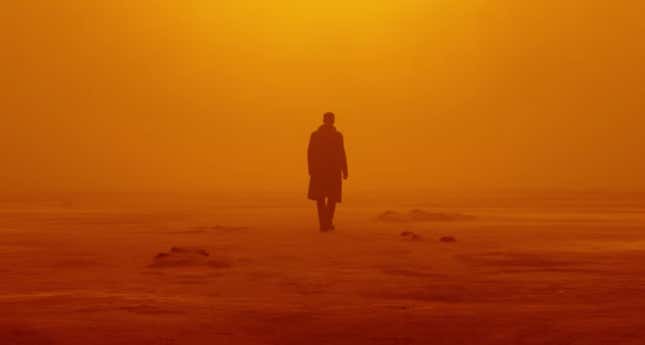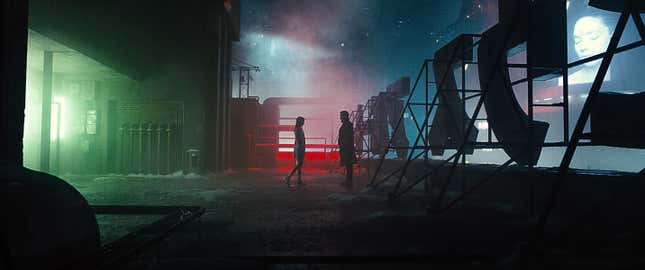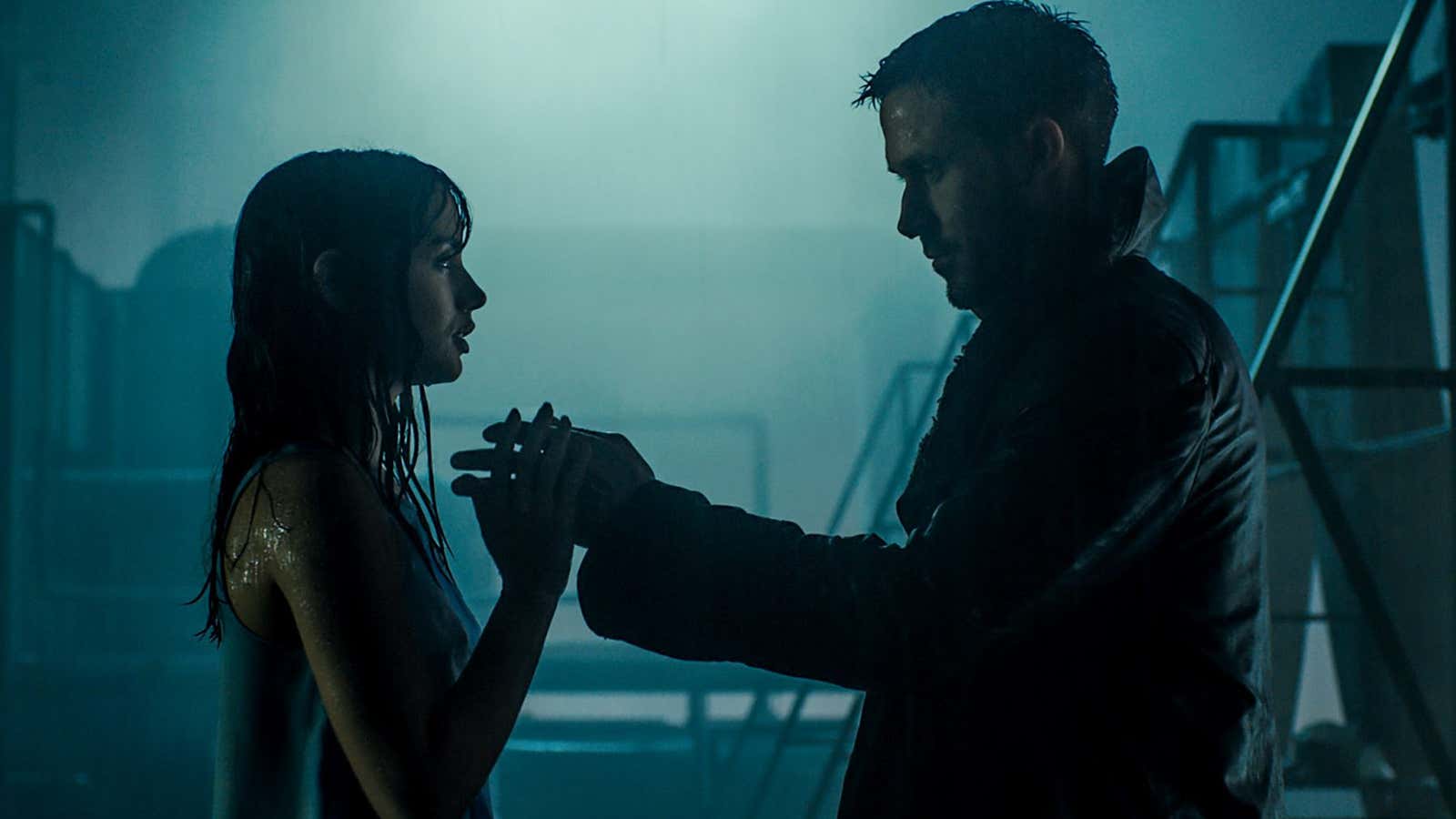This story contains spoilers.
The most profound moment in Blade Runner 2049 sounds like a total throwaway line, delivered in Harrison Ford’s famous wry tone.
“Is he real?” LAPD Officer K (Ryan Gosling) asks Rick Deckard (Ford, reprising his role from the original 1982 film). They’re referring to Deckard’s dog. In this dystopian future, it’s unclear to both K and the audience if Deckard’s spunky canine companion is a living creature, or just something that replicates one.
“I don’t know,” Deckard replies, “Ask him.”
In what’s otherwise a dark and deeply serious film, Deckard’s quip was one of only two or three to elicit laughter in my theater. But as the laughs faded, the depth of the line hung in the air, weighing on me for the remainder of the film and the several days after.
It doesn’t matter if Deckard’s dog is a dog created by biology, or a replica programmed in a laboratory. The dog is as real as anything else in the world because it matters to Deckard. It serves a purpose beyond the fact of its own existence.
Blade Runner didn’t need a sequel. In fact, most films don’t—especially ones built on ambiguity like Scott’s iconic sci-fi noir. So the mandate of Blade Runner 2049, a sequel more than 30 years in the making, was to justify its own existence. It had to blaze its own trail, be its own thing, prove that it’s as essential as the original film was.
Directed by Arrival maestro Denis Villeneuve, Blade Runner 2049 is a film that, like all of us—human and replicant alike— actively wrestles with its own existence. Through the journey of K, the film explores its own place in the world and why it deserves a chance to be seen and felt, if only for a fleeting moment.
Significant spoilers to follow.

Warner Bros. took great pains to prevent press from revealing any significant plot elements from the film, including one that’s revealed within the first five minutes: K, whose job is to track down and “retire” (kill) rogue replicants, is himself a replicant. He is part of a new, advanced series of android, created by the messianic industrialist Niander Wallace (Jared Leto), that obey their orders.
K knows he’s a replicant. Unlike in the first film, there’s no mystery surrounding what K really is. He has memories, but he correctly assumes they were dreamed up in a lab somewhere, implanted in him to better simulate the experience of being human.
The revelation that really kicks off the film, though, is that K, renamed “Joe” by his artificially intelligent hologram girlfriend, Joi, discovers he may have actually been born instead of made—the child of a replicant who somehow became pregnant. This, Joe thinks, gives him new meaning, a higher purpose. It gives him, perhaps, something all other replicants lack, no matter how close in appearance and personality they come to humans: a soul.
Alas, it’s not meant to be. Joe eventually finds out that he is not the replicant child, but is implanted with her memories by rogue replicants to divert the authorities away from the true child. Joe’s memories are indeed real, but they’re not his. Nothing of his is actually his. He’s literally an average Joe.
That is when Joe does something that changes both the course of the film and also the way it interacts with its 30-year-old predecessor. Joe decides on a purpose of his own. He will help the true child—a girl—meet her father, and make his own existence meaningful.
In the days since I saw Blade Runner 2049, I’ve come to believe the film follows a similar path, contemplating its own right to exist as an unnecessary sequel to a great film made decades ago. The plot is a clever metaphor about itself. How does a film inherently unnecessary make itself vital?

Telling a good story is one way, which Blade Runner 2049 mostly does. Ultimately, it’s a moving but undeniably small story in this vast sci-fi universe. It’s a tale you can imagine characters hearing whisperings of, but one that no one really knows well enough to tell on their own because they weren’t there to experience it. There are no huge battles or cataclysmic events. This is Joe’s story, and by the end, he passes it on to someone else.
Niander, the villain, gets away, and we’re left to presume he continues his work manufacturing replicants for slave labor, seeking a way to have them procreate in order to scale faster across Earth’s off-world colonies. Joe, after subverting his programming and achieving what he set out to do, dies. No one will miss him. Hardly anyone knew he even existed. His only companions we know of, Joi and his boss Lieutenant Joshi (Robin Wright), are both killed too. Deckard is really the only person who can keep the legend of his existence alive.
The film has grown on me, especially after reading more writing on it. Immediately after seeing it, I felt a bit hollow—but maybe that, too, is the point, to shock you into submission and then have the bigger ideas gnaw at you in the following days and weeks. Blade Runner 2049 is more thoughtful than many reviewers have given it credit for. It’s a replicant of the original Blade Runner, certainly, but one, like Joe, and perhaps like Deckard’s dog, with a soul.
Beyond the compelling story or its sublime visuals or Villeneuve’s confident, stylish direction, Blade Runner 2049 succeeds most of all because it just tries. It’s an undisguised swing for the fences. It is, in my estimation, the least cynical major Hollywood sequel in a long time. Blade Runner is not Star Wars—it’s not a cultural behemoth with boundless marketing and merchandise opportunities. It’s an ambitious but vulnerable and introspective film, and Blade Runner 2049, I think, will be viewed in a similar sense in 2052.
I find it unlikely that anyone, three and a half decades from now, will question why Villeneuve’s film got made. For it asks the same questions we all ask ourselves, all the time, every day: Why we exist, and just what the hell we’re here to do.
